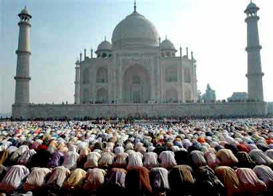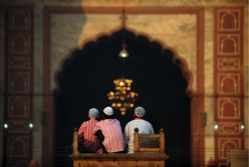Non-state actors have a considerable impact on the field of public diplomacy in a fast-converging world marked by increased interaction among publics and civil society groups across the globe. Sometimes, efforts by non-state...
KEEP READINGThe CPD Blog is intended to stimulate dialog among scholars and practitioners from around the world in the public diplomacy sphere. The opinions represented here are the authors' own and do not necessarily reflect CPD's views. For blogger guidelines, click here.
India Blog Series: The Portrayal of Islam in Indian Mass Media
APDS Blogger: Anna Dawson
After meeting today with Navdeep Suri, Joint Secretary & Head of the Public Diplomacy Division in India, we learned that in the context of the Arab Spring, India is promoting Islam as an important aspect of Indian history and culture. One way to look at how well this is being done in India is to look at the way Indian mass media portrays Islam. It appears that Islam is often under- and mis-represented in the Indian media in both the Hindi and Urdu languages. This is important for public diplomacy because what India projects to the rest of the world has to accurately reflect what is happening internally to gain credibility. Because of the disconnect between a democracy that supports all people and a media that doesn't reflect this, India should reexamine the way that people in-country see themselves and their own identities before projecting an image abroad.
The Indian sub-continent is known for its ethnic, cultural, and linguistic diversity. With this diversity comes the conflict of competing ideologies, and the debate plays out in the mass media.

Islam is the second-most practiced religion in India after Hinduism, with over 13% practicing Muslims—or more than 138 million people. However, oftentimes the mainstream Indian media misrepresents and underrepresents the Muslim Indian population and does not always accurately reflect the reality of the millions of Muslims in India. A combination of factors influence the way that Islam is portrayed in Indian mass media, which include:
Hindi is the most commonly spoken language in India, and Hindi newspapers therefore have a multi-million readership
in the country. These papers are run by elites and higher castes that have the education and ability to pursue a career in journalism. It is important to remember that these papers are a business and ‘saleability’ means a lot, especially in terms of dealing with minorities. Therefore, looking for the extreme voices and areas of conflict brings in more profit rather than, say, a Hindu and a Muslim sitting down and having a reasoned debate. Hindi-language media concentrates on the sensational aspects of Islam, having a tendency to extend these generalizations to the Indian Muslim population as a whole.

Most Muslim representations in Indian media are limited to the Urdu-language media. This fact comes with a lot of challenges and pitfalls to portraying a more moderate view of Islam within India. First of all, Urdu is considered to be a language of the madrasah-educated north Indian poor, so it is difficult for newspapers to sell ad space to generate revenue. Without the necessary revenue, the quality and professionalism of these papers decreases. Many of these papers therefore have poor working conditions, low salaries, and outdated equipment. These monetary conditions are not conducive to good, solid journalism.
There seems to be a huge potential for an Urdu-language media group to come in and rectify the situation currently facing the Urdu press. There is a vacuum for solid, professional Urdu journalism, and someone with the monetary means could help the Urdu press change their view of self to help promote positive and objective overall news coverage of Islam in India. By changing the narrative of self, the portrayal to the rest of the country can be improved.
While both Hindi and Urdu newspapers deal with the topic of Islam and Muslims differently, there are some similarities in the way that Muslims are portrayed. Ironically, neither Urdu nor Hindi give much attention to positive achievements of the Muslim community. Because of the business nature of the industry, sensational stories and negative events are given more time and space. This makes for more ‘marketable’ news that ignores many problems that Muslims face within India, including educational problems, economic stratification, and social injustices.
Often, there is a lack of a ‘moderate’ or average Muslim voice being heard in either Hindi or Urdu news. The main spokespeople for Islam and Muslims that are most easily accessible tend to be the authoritative, conservative community leaders, or ulemas-- thus offering only one view of a situation. In order for the portrayal of Indian Muslims to change, more voices need to be heard. The views of the ulemas do not speak for an entire community, much as the views of congress do not speak for the entire U.S. population. These usual suspects tend to use Islam as self-promotion and publicity and do not have the interests of the Indian Muslim masses in mind.
Should the journalists be responsible for seeking out alternate views, or should more Indian Muslims seek out media to share their views? The answer seems unclear, and I argue that a combination of better journalism and an active interest in self-portrayal from Indian Muslims will be the optimal output to change Indian media’s portrayal of Muslims—both Hindi and Urdu speaking.
Anna Dawson is a Master of Public Diplomacy candidate and a Senior Editor for USC’s Public Diplomacy Magazine. She is also participating in the India:Inside Out Project. This past summer, she interned at the Center for International Private Enterprise in Washington, DC.
Visit CPD's Online Library
Explore CPD's vast online database featuring the latest books, articles, speeches and information on international organizations dedicated to public diplomacy.
POPULAR ARTICLES
-
March 22
-
April 18
-
April 1
-
April 11
-
March 4
Join the Conversation
Interested in contributing to the CPD Blog? We welcome your posts. Read our guidelines and find out how you can submit blogs and photo essays >.












